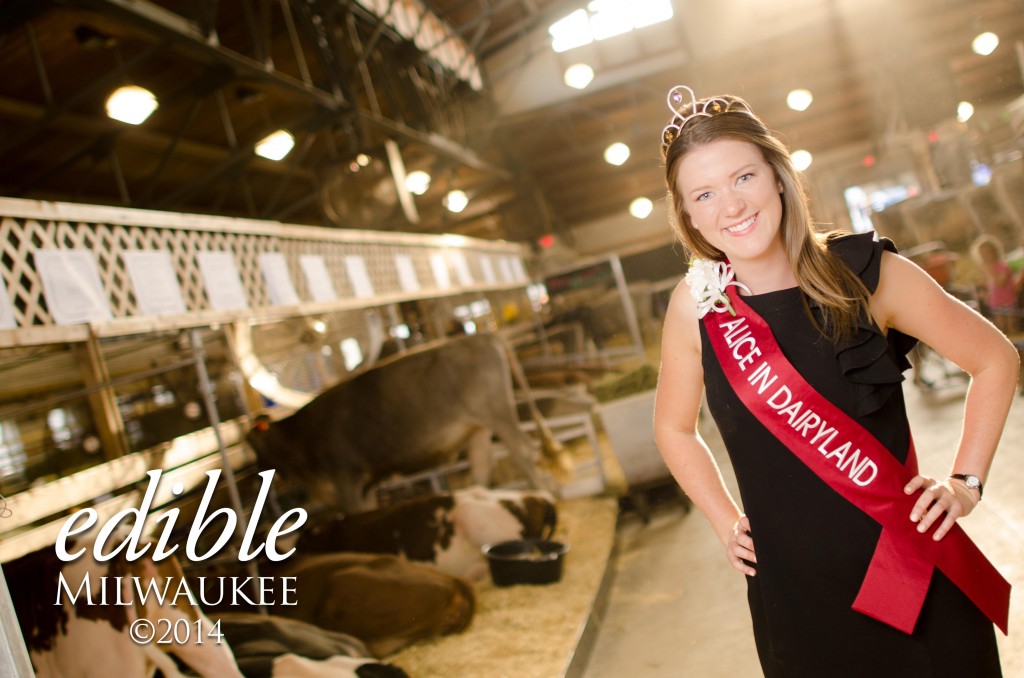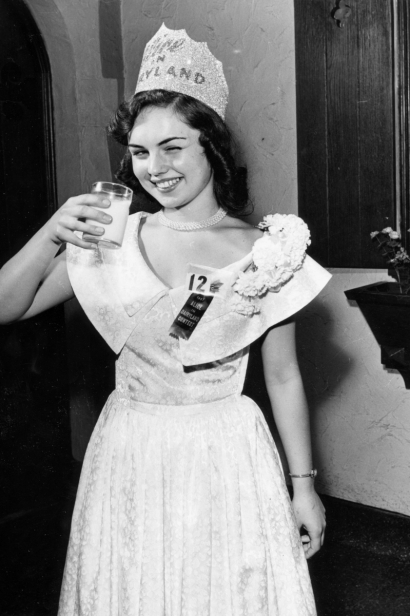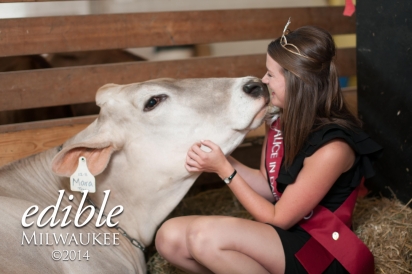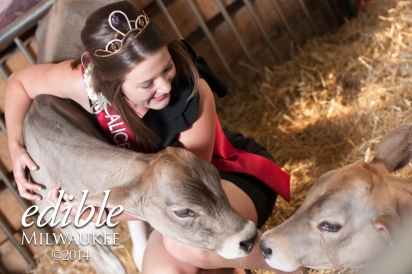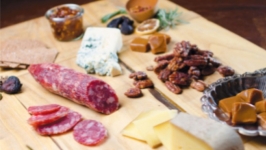Wisconsin’s Goddesses and Queens
Wisconsin’s Alice in Dairyland, women farmers grow from rich history
She’s milked a cow with rocker Alice Cooper. She’s danced with Lawrence Welk on TV. She’s appeared in the Rose Parade.
She is Alice in Dairyland and she’s been Wisconsin’s agricultural royalty for 66 years. Alice travels the state during her yearlong reign talking up the importance of farming. Despite her name, she’s more than just dairy, and more than just an agriculture beauty queen.
“I cover the diversity of Wisconsin’s agricultural sector from mink and cranberries to ginseng and ethanol,” says Zoey Brooks, the 67th (and current) Alice in Dairyland. “It’s a marketing job, and I spend most of my time on the road trying to be a positive voice for agriculture in Wisconsin.”
Wisconsin’s royalty isn’t confined to Alice. We’ve also got a cranberry queen, a honey Queen, a Brown Swiss Queen, a Hereford Association Queen, a maple Queen, and a Cherry Blossom Princess, among others. While they may seem a little silly and outdated today, these agricultural queens have an ancient history.
The Goddesses
For thousands of years, women have been associated with agriculture and the harvest. Women are symbolic of the earth’s fertility and abundance, the very things people hoped for their crops. Fertility goddesses, particularly Mother Earth, were important figures in the ancient world, from Asia and Africa to Europe and South America.
The Greeks had Demeter who was said to have invented agriculture and all of the rituals associated with it. The Romans had their own Demeter named Ceres, a regal woman often shown holding a scepter, carrying a basket of flowers and fruit, and wearing a garland of wheat. In Indonesia, goddess Hainuwele was the first to domesticate fruit trees. Hindu goddesses watched over food, the harvest, and nourishment.
In North and South America, a Corn Mother gave life to the continents’ staple crop. Corn along with beans and squash, frequently grown together, were known as the Three Sisters because the plants were said to embody female spirits.
Virtually all divinities of cooking, hearth, and home also took female form, from Roman Vesta and Baltic Gabija to Celtic Brigit and Japanese Kamui Fuchi. The Aztec goddess Chantico personified and safeguarded the hearth fires, protecting the families that gathered around this essential place in the home.
From Divine to Prosaic
Divinities weren’t the only women getting their hands dirty. Women have been responsible for growing, harvesting, storing, and preparing food for themselves and their families from the advent of modern agriculture to today.
Anne Pickett in 1841 turned what had long been a farm wife’s job, processing excess milk into cheese for home use, into a business. That year she rented cows from her neighbors near Lake Mills and established the state’s first cooperative cheese operation in her kitchen, earning herself the title of the state’s first cheesemaker.
“No man can run a farm without some one [sic] to help him,” wrote one Wisconsin farm wife around 1900. “I have always been called upon and expected to help do anything that a man would be expected to do.”
Dr. Juliet Severance of Whitewater took a hard line on what she felt to be the unacknowledged and unappreciated importance of farm women. “The farmer’s wife is as much a factor in the success of farm life as is the farmer himself,” she declared in a speech before the Wisconsin State Agricultural Society in 1886. The wife who “works more hours than he does owns nothing, not even herself, her husband, or the children.” She further asserted that a woman could run the farm better on her own than her husband could without her labor. Women had, in fact, demonstrated their skill in doing just that during the Civil War, when they took to the fields while men went to war.
Wisconsin farm families began gathering at local agricultural fairs for social and educational purposes in the mid-19th century. These types of food and harvest fairs had begun in Europe centuries before in the 1500s. At these fairs, agricultural societies showcased the latest technological innovations and displayed the literal fruits of their labors. Women attendees often competed in contests that judged their productive capabilities on the farm. From soapmaking and dressmaking, the step to evaluating women’s face and form to crown a food queen is not hard to make.
Queen Alice
Wisconsin’s queenly lines go back at least as far as 1923, when Monroe launched a cheese festival presided over by royal ambassadors. The state’s most famous queen got her start in 1948 during Wisconsin’s centennial year. Margaret McGuire Blott had the honor of being the first Alice in Dairyland, and she hosted the State Fair’s Centennial Exposition.
Alice’s early years were a bit strange. For several seasons, a 10-foot tall mechanical Alice greeted guests at the State Fair. The real Alice sat backstage, working levers to make Big Alice sit and stand, and answering questions through a speaker in the doll’s mouth. Mechanical Alice apparently delighted rather than scared fairgoers, and she returned each year with a slight makeover. To make sure Big Alice looked like that year’s reigning woman, organizers changed the doll’s complexion, hair, and eye color.
Although Alice still wears a tiara, the Alice in Dairyland program has changed with the times. The first Alice was selected for her looks alone. The state’s centennial commission sent out a call for photographs and chose Blott from among the 500 submissions. Selecting Alice is far more complex today.
Candidates submit a resume, write essays, and give speeches. Fewer women apply for the job with this more rigorous process but it also helps to ensure that the candidates can handle the challenge of representing the range of Wisconsin agriculture.
Some challenges are harder to prepare for than others. Debbie Crave, Wisconsin’s 34th Alice, entered a crawfish eating contest in New Orleans against a member of the New Orleans Saints football team.
“I was so grossed out to see this plate piled with crawfish. I didn’t have a clue how you ate them but I learned how to squeeze their little heads and I never forgot it,” says Crave, laughing. (She didn’t win.)
But what really stands out for Crave are the people she met and the opportunity to be a part of the Alice legacy.
“It’s a remarkable platform to occupy,” says Crave. “You see firsthand the dedication of people around the state and get to help share their story.”
Today’s Alice logs more than 40,000 miles and speaks at roughly 400 events, including daily appearances at the Wisconsin State Fair. Each Alice brings her own focus and interest to the job. Brooks hopes to use her position to promote women in agriculture.
Brooks grew up on a dairy and grain farm in Waupaca that’s been in her family since 1855. Her passion for farming began as a kid and carried her through a major in animal science at UW-Madison. She plans to return to the farm at the end of her Alice year.
“More women are going into production agriculture, and are taking over farms,” says Brooks. “I think it’s an exciting time for us.”
Women Down on the Farm
Of course, women have always been farming; they just haven’t been counted.
Until recently, women were viewed as behind-the-scenes sidekicks to their husbands despite the very real and very hard work women have done to support the farm. USDA policies mirrored this prejudice, denying women loans and other forms of assistance that have resulted in numerous discrimination lawsuits. Women also failed to appear in farm statistics. Only since 1978 has the USDA asked for the gender of the principal farm operator in its Agricultural Census. And since then, the number of women-owned farms has become one of the fastest-growing segments of new farmers.
“It’s a very fruitful time for beginning farmers, especially women in midlife who are coming to farming in huge numbers,” says Lisa Kivirist. “We call it ‘encore farming’ as these women are bringing different, non-farming skills to the field from their previous jobs.”
Kivirist coordinates the Rural Women’s Project program of the Midwest Organic and Sustainable Education Service (MOSES), which aims to increase the impact of and resources for women in sustainable farming. She’s also a farmer herself, running the sustainable Inn Serendipity Bed & Breakfast near Monroe with her husband, John Ivanko.
The number of farms operated by women nearly tripled over the past three decades, from 5 percent in 1978 to 14 percent in 2007. Most of these farms are small, sustainable operations. The women themselves are younger than the national average.
“The number of farms operated by women nearly tripled over the past three decades, from 5 percent in 1978 to 14 percent in 2007. Most of these farms are small, sustainable operations. The women themselves are younger than the national average.”
Plenty of women also work with their husbands or other men on farms. While about 300,000 women own their own farms, the USDA counts approximately 1 million women who help run a farm. These secondary farm operators—usually women—have only been counted since 2002.
But even with that growth, agricultural resources for women are sparse. Until recently, something as basic to farming as tools were designed with only a man’s frame in mind. Most women look to other women for advice.
“In rural areas, women are isolated by geography as well as gender,” says Kivirist. “We’re really trying to forge connections between women farmers, to share knowledge and experiences as well as their hardships. Farming is hard work no matter what gender you are.”
The Rural Women’s Project organizes daylong “In Her Boots” workshops on women-owned farms throughout the Midwest during the growing season as well as a public tour of women-operated organic farms known as the “Soil Sisters” in south central Wisconsin.
“It’s such a positive group of women with a passion to change how we eat,” says Kivirist. “Women are the pulse in food system change.”
Alice in Dairyland is a part of that woman-to-woman story as well. Female agricultural role models are hard to find. The title may seem trite but it does grab attention.
“Women have always been in agriculture. They just haven’t gotten the credit,” says Crave. “Alice in Dairyland is the most visible spokesperson for women in Wisconsin agriculture.”
Alice in Dairyland and Wisconsin’s other queens aren’t just some pre-feminist holdover from the past. They, along with farm and harvest festivals, recall an agricultural heritage that stretches back thousands of years to people and cultures around the world. And as women, these queens and their divine predecessors are perhaps apt symbols for the new, increasingly female face of farming’s future.


